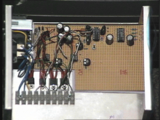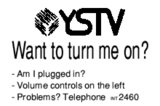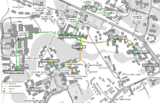New Broadcast Network: Difference between revisions
mNo edit summary |
(Add words) |
||
| Line 1: | Line 1: | ||
== System options == | |||
Several options existed at the time with varying levels of expense | |||
* A baseband signal sent over coaxial cable (with sound modulated on top) | |||
* Digitising the signal in some way | |||
* Using balanced line video and audio as tested in the [[Vanbrugh Upgrade]] | |||
* Obtaining a license for a small transmitter | |||
The development effort for an all digital system was prohibitively long, and while the coaxial system had merits in bandwidth terms the cost of the cable ruled it out. The decision was made to select twisted pair cabling on the basis that getting some new cabling installed was the most important step: a digital system could always reuse any cable in the future following an initial analogue installation. | |||
Also, [[Owain Davies]] had contructed a 19" rack unit with 6 balanced line video outputs and matching audio drivers off his own back, so half of the transmission system was already built and tested. | |||
== New cabling == | |||
In summer 1998 an ambitious 2km of 3-pair plus overall screen cable was installed, following an initial mixup which had seen 2km of 3 core mains cable delivered to the station instead. | |||
Timing was opportune as this was the same summer that a private contractor was installing about the same amount of cabling for the one-per-room campus telephones for student's bedrooms. Often a route could be covered by following the private contractors while the covered walkway panels were removed, though sometimes they followed the YSTV installation too. | |||
The new cabling was anonymous and grey, so to help prevent it being cut in the future it was marked at each access point or missing ceiling tile with 'YSTV' on a band of yellow electrician's tape. This can still be clearly seen where some trunking is missing on the way up to the JB Morrell library as at 2007. | |||
=== Key equipment === | |||
All of the best equipment was available to aid the team, including | |||
* Some dowel previously used to hold up the [[Black drapes]] | |||
* An old length of washing line | |||
* A torch, well a couple of torches actually as one was left in the walkway outside Vanbrugh by mistake | |||
* A step ladder | |||
* The long step ladder borrowed from the Drama Barn | |||
* An electric screwdriver and a bag of washers and screws - the walkways had lost many of their screws over the years | |||
=== Navvies === | |||
Chief installers [[Tim Hackett]], [[Rob Sprowson]], and briefly [[Will Irvine]] and [[Alex Hudson]] worked unfeasably long hours to get all of the cabling in place for start of term. [[Peter Bowles]] also came in handy where cabling down small tunnels was required, it was easier to send down a low paid human than trying to push the cables through with rods. | |||
=== Tricky bits === | |||
On the whole, the university's use of wooden covered walkways made cable installation fairly simple with a few notable exceptions | |||
* The crossroads outside LTC and Central hall, massive bundles of other power cables, fire alarm cables, network and communications cables all met here and the walkway was completely full. A can of WD40 was used to grease the cables so that they could be dragged past this section | |||
* Central hall, an impenitrable concrete fortress not intended to ever have any wires added to it once contructed | |||
* The under road tubing from Biology to Wentworth, the tubing had blue pull through ropes so laying cables was quite simple, but the area was infested with thousands of itchy biting flies | |||
* Over Vanbrugh kitchens, through the high voltage substation, with a little supervision from Steve Stead in Estates department | |||
== Receivers == | |||
The receiver units were all built by [[Rob Sprowson]] based on cloning the video receiver from Owain's Vanbrugh prototype, with the addition of an on board distribution amplifier to directly drive up to 4 sets. The audio driver used was an SSM2142/SSM2141 transmitter and receiver pair, again balanced line, with two copies of the circuitry present to allow for future stereo transmissions (only one half was populated to save money). | |||
[[Image:NetboxGuts.png|left|thumb|160px|Inside the new network receiver]] | [[Image:NetboxGuts.png|left|thumb|160px|Inside the new network receiver]] | ||
[[Image:WantToTurnMeOn.png| | |||
With the exception of Vanbrugh, which had relatively new SCART capable televisions, an entire new set of Finlandia televisions were purchased from 'Tony and Brian' in the Midlands. Being ex-rental sets they automatically turned on to ITV via the tuner, and had to be modified internally with some minor track cuts and wire links to force them to switch to the external AV channel (while still appearing to be on ITV on the facia). | |||
The advantage of this commonality meant that any faulty sets could easily be compared side by side with known working ones, and often it was necessary only to look at which components were clean in a working set to see where they had been repaired in one but not the other. For some reason the majority of the televisions smelt of cigarettes. | |||
[[Image:WantToTurnMeOn.png|right|thumb|160px|Network prompt label]] | |||
Lead by [[Paul Leader]] and later rebranded by [[Matt Hammond]] the monitors were all marked with laminated front panel sticker - often obscuring the redundant channel changer buttons, hinting at how to work the television in the absence of a remote control: a common failing of previous installations, being frequently maltreated by people trying to work out how to turn up the volume. | |||
A service history sticker was added to the rear, but seldom used. | |||
== Post fix additions == | |||
[[Image:Net2000Rough.png|left|thumb|160px|Schematic of 1998 installation]] | [[Image:Net2000Rough.png|left|thumb|160px|Schematic of 1998 installation]] | ||
Revision as of 17:33, 18 November 2007
System options
Several options existed at the time with varying levels of expense
- A baseband signal sent over coaxial cable (with sound modulated on top)
- Digitising the signal in some way
- Using balanced line video and audio as tested in the Vanbrugh Upgrade
- Obtaining a license for a small transmitter
The development effort for an all digital system was prohibitively long, and while the coaxial system had merits in bandwidth terms the cost of the cable ruled it out. The decision was made to select twisted pair cabling on the basis that getting some new cabling installed was the most important step: a digital system could always reuse any cable in the future following an initial analogue installation.
Also, Owain Davies had contructed a 19" rack unit with 6 balanced line video outputs and matching audio drivers off his own back, so half of the transmission system was already built and tested.
New cabling
In summer 1998 an ambitious 2km of 3-pair plus overall screen cable was installed, following an initial mixup which had seen 2km of 3 core mains cable delivered to the station instead.
Timing was opportune as this was the same summer that a private contractor was installing about the same amount of cabling for the one-per-room campus telephones for student's bedrooms. Often a route could be covered by following the private contractors while the covered walkway panels were removed, though sometimes they followed the YSTV installation too.
The new cabling was anonymous and grey, so to help prevent it being cut in the future it was marked at each access point or missing ceiling tile with 'YSTV' on a band of yellow electrician's tape. This can still be clearly seen where some trunking is missing on the way up to the JB Morrell library as at 2007.
Key equipment
All of the best equipment was available to aid the team, including
- Some dowel previously used to hold up the Black drapes
- An old length of washing line
- A torch, well a couple of torches actually as one was left in the walkway outside Vanbrugh by mistake
- A step ladder
- The long step ladder borrowed from the Drama Barn
- An electric screwdriver and a bag of washers and screws - the walkways had lost many of their screws over the years
Chief installers Tim Hackett, Rob Sprowson, and briefly Will Irvine and Alex Hudson worked unfeasably long hours to get all of the cabling in place for start of term. Peter Bowles also came in handy where cabling down small tunnels was required, it was easier to send down a low paid human than trying to push the cables through with rods.
Tricky bits
On the whole, the university's use of wooden covered walkways made cable installation fairly simple with a few notable exceptions
- The crossroads outside LTC and Central hall, massive bundles of other power cables, fire alarm cables, network and communications cables all met here and the walkway was completely full. A can of WD40 was used to grease the cables so that they could be dragged past this section
- Central hall, an impenitrable concrete fortress not intended to ever have any wires added to it once contructed
- The under road tubing from Biology to Wentworth, the tubing had blue pull through ropes so laying cables was quite simple, but the area was infested with thousands of itchy biting flies
- Over Vanbrugh kitchens, through the high voltage substation, with a little supervision from Steve Stead in Estates department
Receivers
The receiver units were all built by Rob Sprowson based on cloning the video receiver from Owain's Vanbrugh prototype, with the addition of an on board distribution amplifier to directly drive up to 4 sets. The audio driver used was an SSM2142/SSM2141 transmitter and receiver pair, again balanced line, with two copies of the circuitry present to allow for future stereo transmissions (only one half was populated to save money).
With the exception of Vanbrugh, which had relatively new SCART capable televisions, an entire new set of Finlandia televisions were purchased from 'Tony and Brian' in the Midlands. Being ex-rental sets they automatically turned on to ITV via the tuner, and had to be modified internally with some minor track cuts and wire links to force them to switch to the external AV channel (while still appearing to be on ITV on the facia).
The advantage of this commonality meant that any faulty sets could easily be compared side by side with known working ones, and often it was necessary only to look at which components were clean in a working set to see where they had been repaired in one but not the other. For some reason the majority of the televisions smelt of cigarettes.
Lead by Paul Leader and later rebranded by Matt Hammond the monitors were all marked with laminated front panel sticker - often obscuring the redundant channel changer buttons, hinting at how to work the television in the absence of a remote control: a common failing of previous installations, being frequently maltreated by people trying to work out how to turn up the volume.
A service history sticker was added to the rear, but seldom used.


